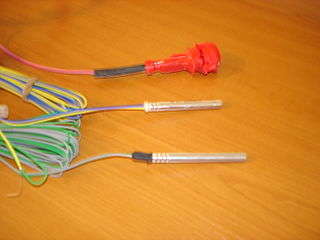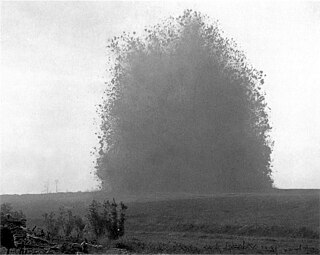
An explosive is a reactive substance that contains a great amount of potential energy that can produce an explosion if released suddenly, usually accompanied by the production of light, heat, sound, and pressure. An explosive charge is a measured quantity of explosive material, which may either be composed solely of one ingredient or be a mixture containing at least two substances.

Semtex is a general-purpose plastic explosive containing RDX and PETN. It is used in commercial blasting, demolition, and in certain military applications.

Trinitrotoluene, more commonly known as TNT (and more specifically 2,4,6-trinitrotoluene, and by its preferred IUPAC name 2-methyl-1,3,5-trinitrobenzene), is a chemical compound with the formula C6H2(NO2)3CH3. TNT is occasionally used as a reagent in chemical synthesis, but it is best known as an explosive material with convenient handling properties. The explosive yield of TNT is considered to be the standard comparative convention of bombs and asteroid impacts. In chemistry, TNT is used to generate charge transfer salts.

A shaped charge is an explosive charge shaped to focus the effect of the explosive's energy. Different types of shaped charges are used for various purposes such as cutting and forming metal, initiating nuclear weapons, penetrating armor, or perforating wells in the oil and gas industry.

Pentaerythritol tetranitrate (PETN), also known as PENT, pentyl, PENTA, TEN, corpent, or penthrite, is an explosive material. It is the nitrate ester of pentaerythritol, and is structurally very similar to nitroglycerin. Penta refers to the five carbon atoms of the neopentane skeleton. PETN is a very powerful explosive material with a relative effectiveness factor of 1.66. When mixed with a plasticizer, PETN forms a plastic explosive. Along with RDX it is the main ingredient of Semtex.

2,4,6-Trinitrophenylmethylnitramine or tetryl (C7H5N5O8) is an explosive compound used to make detonators and explosive booster charges.

A detonator is a device used to make an explosive or explosive device explode. Detonators come in a variety of types, depending on how they are initiated and details of their inner working, which often involve several stages. Types of detonators include non-electric and electric. Non-electric detonators are typically stab or pyrotechnic while electric are typically "hot wire", exploding bridge wire or explosive foil.

ANFO ( AN-foh) (or AN/FO, for ammonium nitrate/fuel oil) is a widely used bulk industrial high explosive. It consists of 94% porous prilled ammonium nitrate (NH4NO3) (AN), which acts as the oxidizing agent and absorbent for the fuel, and 6% number 2 fuel oil (FO). The use of ANFO originated in the 1950s.

Amatol is a highly explosive material made from a mixture of TNT and ammonium nitrate. The British name originates from the words ammonium and toluene. Similar mixtures were known as Schneiderite in France. Amatol was used extensively during World War I and World War II, typically as an explosive in military weapons such as aircraft bombs, shells, depth charges, and naval mines. It was eventually replaced with alternative explosives such as Composition B, Torpex, and Tritonal.
A triggering sequence, also called an explosive train or a firing train, is a sequence of events that culminates in the detonation of explosives. For safety reasons, most widely used high explosives are difficult to detonate. A primary explosive of higher sensitivity is used to trigger a uniform and predictable detonation of the main body of the explosive. Although the primary explosive itself is generally a more sensitive and expensive compound, it is only used in small quantities and in relatively safely packaged forms. By design there are low explosives and high explosives made such that the low explosives are highly sensitive and high explosives are comparatively insensitive. This not only affords inherent safety to the usage of explosives during handling and transport, but also necessitates an explosive triggering sequence or explosive train. The explosive triggering sequence or the explosive train essentially consists of an 'initiator', an 'intermediary' and the 'high explosive'.

Detonating cord is a thin, flexible plastic tube usually filled with pentaerythritol tetranitrate. With the PETN exploding at a rate of approximately 6,400 m/s (21,000 ft/s), any common length of detonation cord appears to explode instantaneously. It is a high-speed fuse which explodes, rather than burns, and is suitable for detonating high explosives. The detonation velocity is sufficient to use it for synchronizing multiple charges to detonate almost simultaneously even if the charges are placed at different distances from the point of initiation. It is used to reliably and inexpensively chain together multiple explosive charges. Typical uses include mining, drilling, demolitions, and warfare.

Ammonal is an explosive made up of ammonium nitrate and aluminium powder. TNT is added to create T-ammonal which improves properties such as brisance. The mixture is often referred to as Tannerite, which is a brand of ammonal.

A phlegmatizedexplosive is an explosive that has had an agent added to stabilize or desensitize it. Phlegmatizing usually improves the handling properties of an explosive
Astrolite is the trade name of a family of explosives, invented by chemist Gerald Hurst in the 1960s during his employment with the Atlas Powder Company. The Astrolite family consists of two compounds, Astrolite G and Astrolite A. Both are two-part liquid-state high explosive mixtures, composed of ammonium nitrate oxidizer and hydrazine rocket fuel. The explosives were extensively studied, manufactured, and used in many countries because of their advantages of high energy, excellent performance, and wide application. They still find some use in commercial and civil blasting applications, but have mostly been superseded by cheaper and safer compounds, largely due to the expense and exceptionally poisonous nature of the hydrazine component.

Octol is a melt-castable, high explosive mixture consisting of HMX and TNT in different weight proportions.
PLX, abbreviation of Picatinny Liquid Explosive, is a liquid binary explosive. It is a mixture of 95% nitromethane (NM) along with 5% ethylene diamine (EDA) as a sensitizer. Other amine compounds can be used instead of ethylene diamine, such as triethylene tetramine, diethylenetriamine or ethanolamine, but EDA has been found to be the most effective amine additive. PLX is a fairly powerful high explosive, marginally exceeding the destructive yield of TNT.
The AC NM AE T1 is a Brazilian minimum metal anti-tank blast mine. The mine is believed to be in service with the Brazilian army, although production of the mine ceased in 1989. The mine has a square plastic main body, with a raised circular pressure plate and fuze. A carry handle is built into one side of the mine. It appears to be very similar to the PRB M3.

Erythritol tetranitrate (ETN) is an explosive compound chemically similar to PETN, though it is thought to be slightly more sensitive to friction and impact.
Ednatol is a yellow high explosive, comprising about 55% ethylenedinitramine and 45% TNT by weight. It was developed in the United States circa 1935 and used as a substitute for Composition B in large general purpose and fragmentation bombs. It has a detonation velocity of approximately 7,400 metres per second. It is a uniform blend with a melting point of 80 °C.
Explosive materials are produced in numerous physical forms for their use in mining, engineering, or military applications. The different physical forms and fabrication methods are grouped together in several use forms of explosives.














